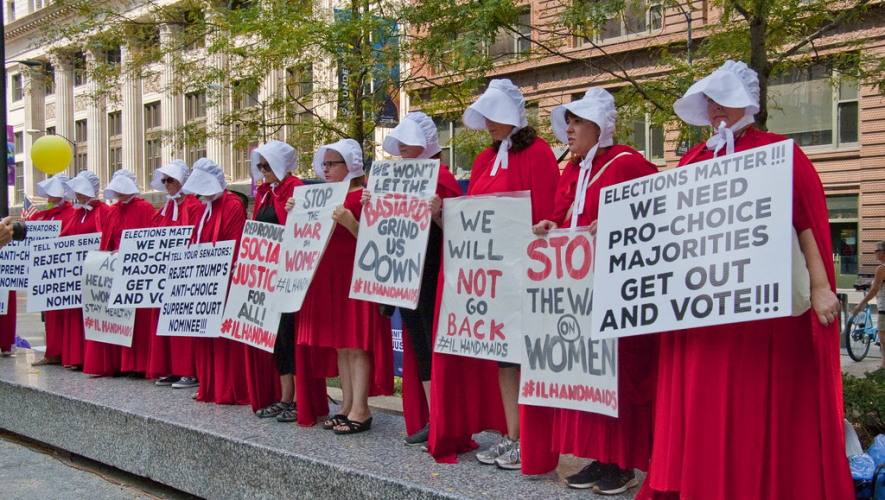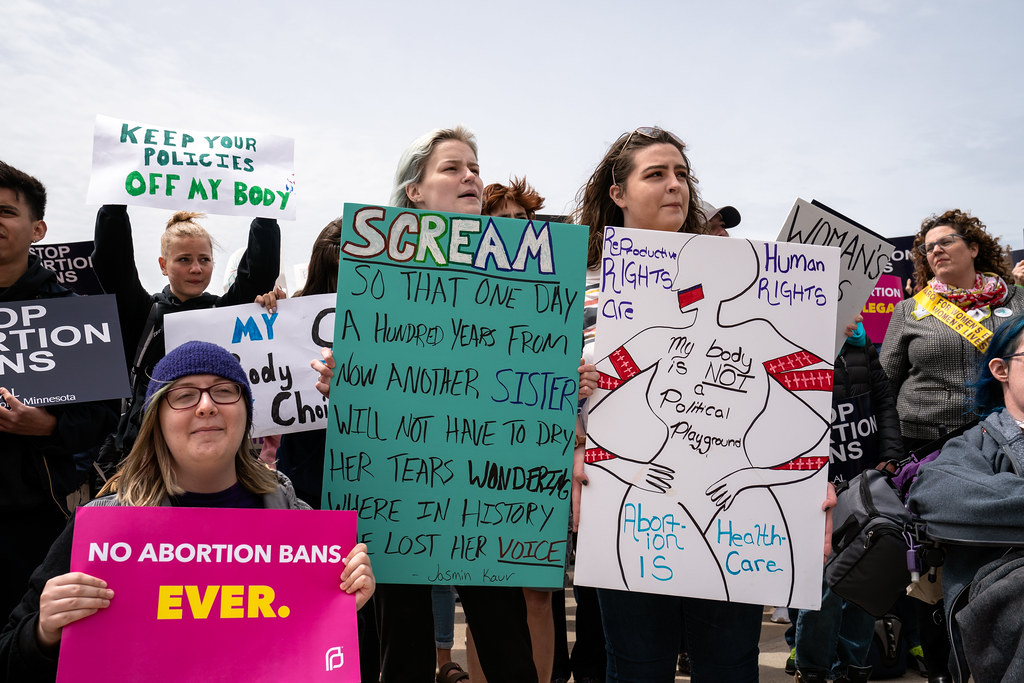Photo by Charles Edward Miller
The Supreme Court’s 1973 decision in Roe v. Wade was a turning point in US history—a celebratory moment where freedom triumphed and the fundamental human rights of bodily autonomy and personal choice were extended to Americans with uteruses.
The landmark decision has been one of great controversy, with efforts to overturn starting from the time of the ruling. The confirmation of Justice Amy Coney Barrett, likely cementing a conservative majority of the Supreme Court for at least a generation, makes that threat even more viable.
As Barrett takes Ruth Bader Ginsburg’s seat, abortion access is just one of many issues in danger of being swayed—among those in jeopardy are LGBTQ+ rights, the Affordable Care Act, access to birth control, worker protections, and the environment.
It’s hard to imagine life without the protections Roe v. Wade grants. The decision led to many social and economic advancements as it stimulated the workforce, increased college enrollment, and decreased poverty and crime across the board in the past two decades. It did much more than federally protect the right to abortion—it revolutionized gender relations and restructured American society.
Life pre-Roe was defined by severe restrictions on women, including a lack of constitutionally protected patient–physician privacy and a lack of liberty to determine personal destiny. Roe also directly impacts many transgender and gender non-conforming people who are often erased from the conversation surrounding the decision and implications of overturning. With that restriction came inherent second-class status, threats of bodily harm, and often death from unsafe, illegal abortions.
The argument against Roe usually falls along religious—often Christian—lines based on a subjective concept of morality that resonates with only a minority of Americans. Indeed, over 60 percent of Americans support preserving access to safe and legal abortion. Those who are pro-choice herald abortion rights as fundamental, while those who are anti-choice—the term “pro-life” being misleading and based in propaganda—deem it a moral sin. But the right to a safe and legal abortion is a human right; the freedom to choose the fate of your body inherently differentiates between freedom and oppression. The United Nations Human Rights Committee affirms that abortion is a human right and that restricting such access violates the right to life. Reproductive rights are human rights.
Photo by Lorie Shaull
While Roe has been under attack for decades, the Trump administration has ushered in an era of renewed action against reproductive rights. In 2016, then-candidate Trump explicitly outlined his anti-abortion beliefs and intention to appoint “pro-life” justices to the court, and he has followed through.
Today, Roe is more of a symbol of federally ensured equality than a guarantee for reproductive justice. The decision has come to represent autonomy beyond the right to abortion—it represents freedom and gender equality more broadly.
In 1992, Planned Parenthood v. Casey became the controlling precedent on abortion. The decision reaffirmed the right to abortion by upholding Roe’s core, but simultaneously granted states new power to restrict the procedure.
The biggest threats to abortion access today are these state-level restrictions and the defunding of organizations dedicated to reproductive justice—abortion access included—such as Planned Parenthood. Since Casey, but especially in the last decade, many Republican-controlled states have enacted abortion restrictions, including six-week bans that criminalize abortions after a fetal “heartbeat” can be detected—long before most people know they are pregnant. Overturning Roe would signal that the opinion of cisgender men is still the federal government’s top priority.
Overturning Roe v. Wade would open the door for more restrictions, virtually eliminating legal abortion in many states. Without Roe, abortion would likely become illegal in twenty-two states; 41 percent of women of reproductive age would see their closest abortion clinics close, slashing their chances of terminating an unwanted pregnancy.
Women lacking money and time cannot simply cross state lines for abortion access. In the year following a Roe reversal, it is predicted that between 90,000 and 140,000 women will be unable to access abortion care due to increased travel distances from clinic closures in red states. That could translate to an increase in self-administered abortions, some of which can cause extensive bodily harm.
Roe v. Wade has consistently taken on ideological perspectives as identity politics define the norms of civic engagement. While the decision outlined bodily autonomy for those capable of reproduction by ensuring the constitutional right to abortion, a central and significant reality of Roe is often overlooked in the discussion.
Overturning the decision would deal a major blow to the American economy. And while it feels reductionary to condense a human rights dilemma to an economic analysis, given that many anti-choice voters are fiscally conservative, they fail to consider the devastating economic impact. Republican-aligned anti-abortion rhetoric, in working to overturn Roe through religiously-based ideology, contradicts core GOP beliefs.
When Roe was decided in 1973, it revolutionized the American workforce. In the years following the decision, not only did the number of reproductive-age women entering the workforce increase dramatically, but so did the number of women aged eighteen to twenty-four enrolled in four-year colleges and universities. Poverty and crime decreased. Providing access to safe and legal abortion saved lives.
When able to choose whether to have children, more people can enroll in college, contribute to the workforce, and accumulate security and personal wealth. When women can fully participate, GDP goes up and poverty goes down. Without Roe, fewer women will contribute to economic growth.
Women denied access to abortion are six times more likely to enroll in federal assistance programs and four times more likely to live below the Federal Poverty Level, a statistic that remained consistant for years after giving birth.
Moreover, if Republicans continue to defund and deregulate government assistance and social welfare, overturning Roe v. Wade would expand the number of families living under the poverty line. Many of the states that passed six-week bans also restricted family planning services and assistance programs. States do not have the infrastructure to accommodate the born, and Republican-led federal initiatives work to ensure that. This disregard for post-womb life negates the term “pro-life,” especially as Black families are disproportionally impacted by these cuts.
Photo by Lorie Shaull
Access to abortion is not simply an ideological battleground. While the attack on reproductive justice is at the forefront of the decision, there are far-reaching implications for the nation as a whole if Roe is overturned. The structure of the US economy may be permanently changed—a reality that must be brought to the forefront of the conversation around health care and constitutional protection.
With the right to choose comes the bodily autonomy essential to being an equal citizen. Without autonomy to choose, people with uteruses are denied the capacity to make personal decisions and lack the democratic freedom and civil rights to master their own destinies.
As the discussion of abortion access remains a key issue among voters, a shift from ideological warfare to Roe v. Wade’s economic impact must be emphasized. Shifting from social partisanship to policy analysis may be the last attempt of upholding the decision and protecting reproductive rights.
Talks of expanding the Supreme Court have surfaced in light of Ginsburg’s death. Joe Biden has been guarded in discussing whether he would pack the court, but has suggested that his administration may implement judicial reforms.
Court reforms are necessary to ensuring the longevity of abortion rights in the US. Republicans have acted egregiously to promote their agenda, hypocritically advancing confirming Barrett mere weeks before the November election. In 2016, Republicans argued that in an election year, the people should decide the next justice with their vote. Senate Majority Leader Mitch McConnell subsequently blocked the Obama administration from filling the seat.
McConnell also blocked appointments to federal judicial courts during Obama’s final two years, boasting that he was in charge—a clear sign that he doesn’t care about the will of the people. Court packing could be a viable step toward combating this political warfare and appointment weaponization. Better yet, setting term limits for Supreme Court justices might be the only way to combat court-related partisan warfare.
So what can Americans do to preserve reproductive rights and justice in this country? The simple answer is: act now. Vote for local, state, and federal officials who are dedicated to protecting reproductive rights. Call your representatives and urge them to protect Roe. Take to the streets, respond to surveys, and create and sign petitions if you feel compelled to do so—these actions can help legislators visualize where public sentiment lies. Donate to family support and abortion funds.
Act like the lives of your neighbors depend on it, because they do. Act like your life depends on it, because it does.





